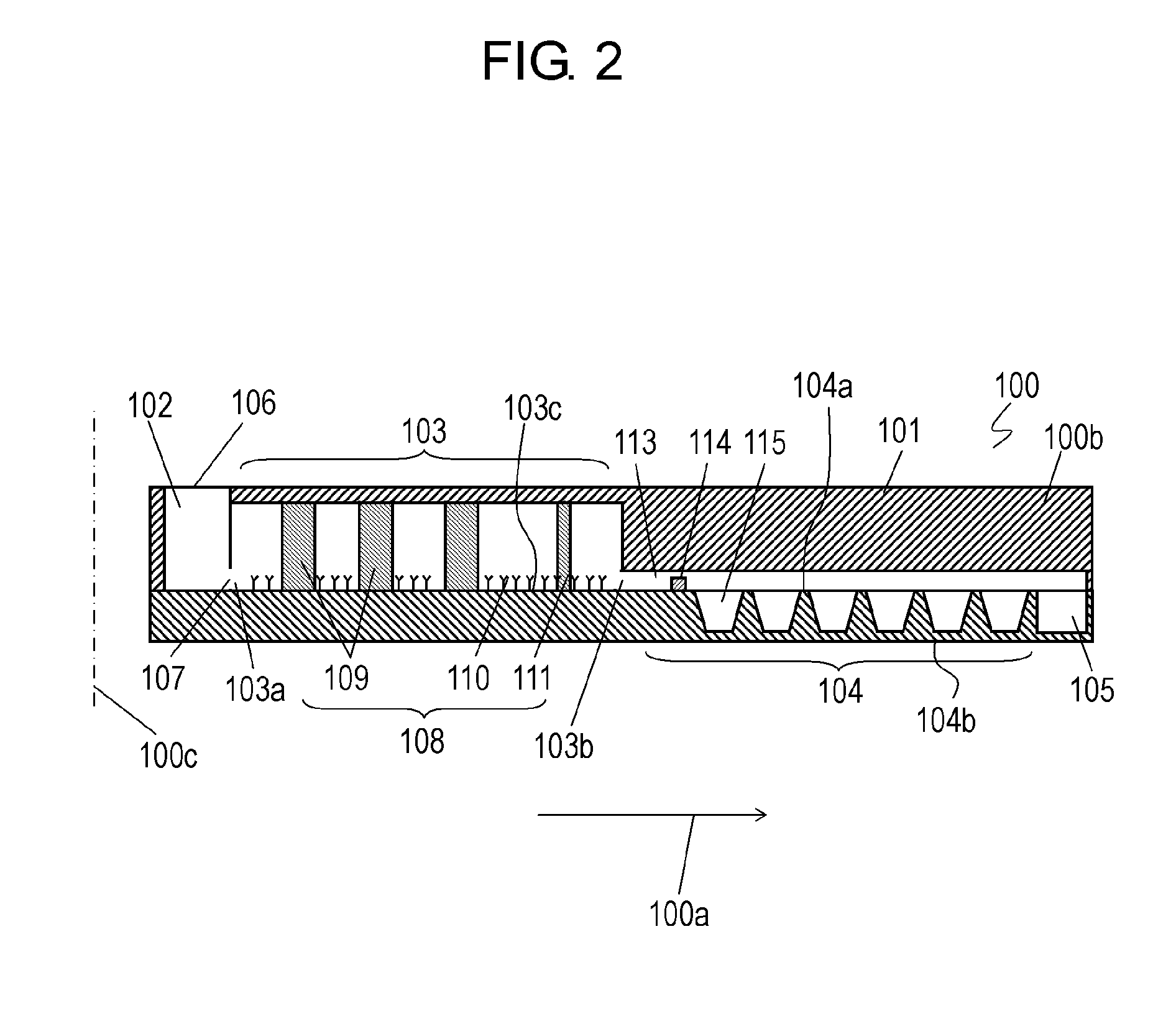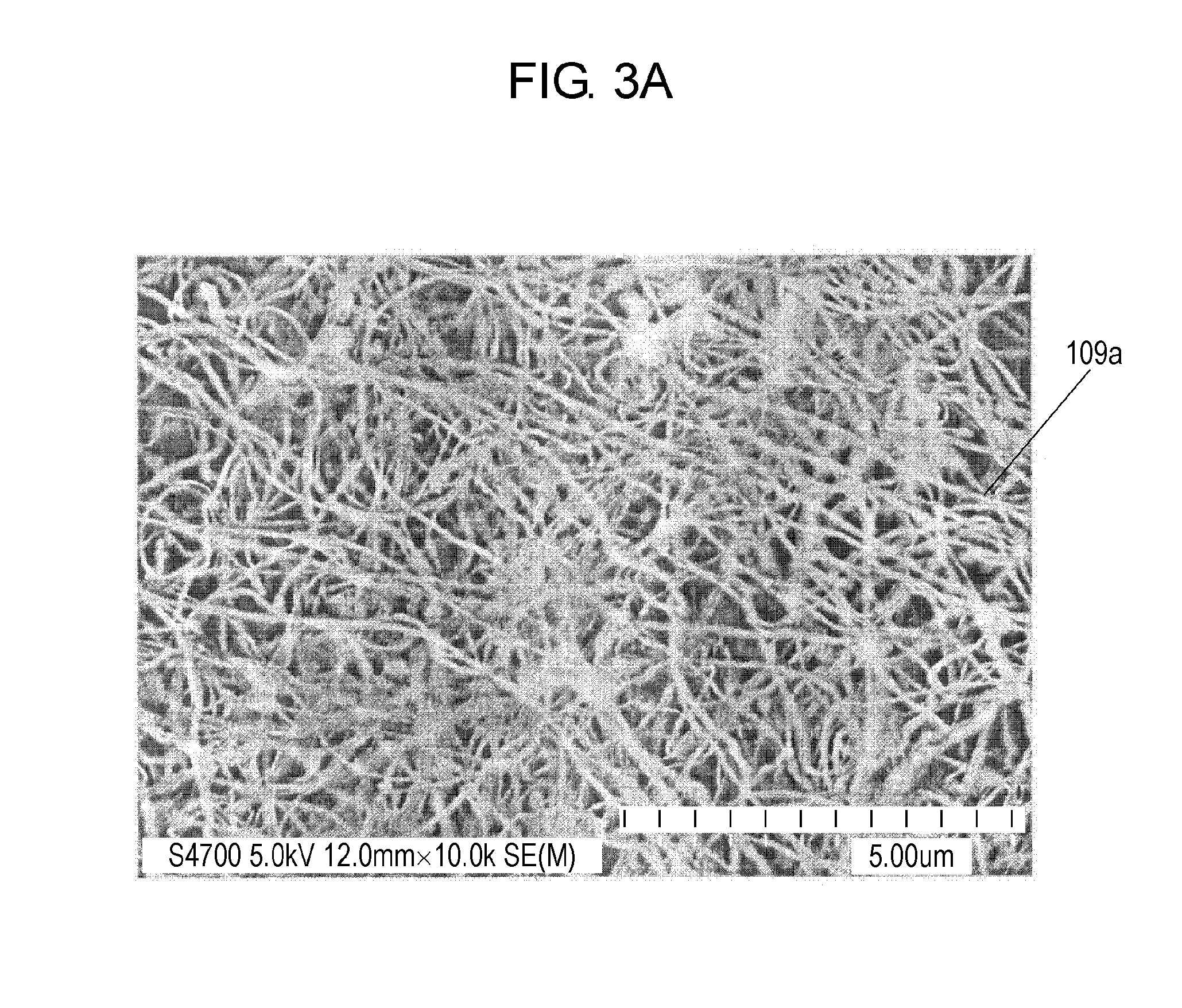Diagnosis kit and method of using the same
a technology of diagnostic kit and kit, which is applied in the field of diagnostic kit, can solve the problems of difficult to diagnose, difficult to detect only a specific substance among a lot of substances contained in a specimen, and high fever, headache, nausea and the like illness
- Summary
- Abstract
- Description
- Claims
- Application Information
AI Technical Summary
Benefits of technology
Problems solved by technology
Method used
Image
Examples
exemplary embodiment 1
[0043]FIG. 1 is a top view of diagnosis kit 100 according to Exemplary Embodiment 1. Diagnosis kit 100 includes base plate 100b and diagnosis plates 101 disposed to base plate 100b. Base plate 100b has a circular shape about center axis 100c. Diagnosis plates 101 are arranged radially at equiangular intervals about center axis 100c to extend in predetermined directions 100a away from center axis 100c. Diagnosis plates 101 enable diagnosis kit 100 to measure (examine) plural biological specimens at once.
[0044]Diagnosis plates 101 can execute a process of diluting a biological specimen and staining nucleic acid thereof, a process of extracting red blood cells, i.e., separating the red blood cells from white blood cells and extract the red blood cells, and a process of disposing the extracted red blood cells. Diagnosis kit 100 can extract a target substance, the red blood cells, from the biological specimen containing the target substance, and examining the target substance.
[0045]The e...
exemplary embodiment 2
[0174]FIG. 9 is a sectional view of diagnosis kit 200 according to Exemplary Embodiment 2. In FIG. 9, components identical to those of diagnosis kit 100 according to Embodiment 1 shown from FIGS. 1 to 8 are denoted by the same reference numerals. Diagnosis kit 200 according to Embodiment 2 includes diagnosis plate 201 and test plate 204 instead of diagnosis plate 101 and test plate 104 of diagnosis kit 100 according to Embodiment 1. Test plate 204 has cavities 215 instead of cavities 115 of test plate 104 according to Embodiment 1. Cavities 215 have shapes different from cavities 115.
[0175]FIG. 10 is a top view of test plate 204. Cavities 215 are provided in surface 104a of test plate 204, similarly to test plate 104 according to Embodiment 1.
[0176]FIG. 11 is a top view of cavity 215. FIG. 12 is a sectional view of cavity 215 at line 12-12 shown in FIG. 11. Cavity 215 has opening 215a opened to surface 104a of test plate 104, bottom surface 215b, and inner wall 215e extending from b...
exemplary embodiment 3
[0187]FIG. 15 is a sectional view of diagnosis plate 301 of diagnosis kit 300 according to Exemplary Embodiment 3. In FIG. 15, components identical to those of diagnosis kit 100 according to Embodiment 1 shown from FIGS. 1 to 8 are denoted by the same reference numerals. Diagnosis kit 300 includes diagnosis plate 301 instead of diagnosis plate 101 according to Embodiment 1. Diagnosis kit 300 according to Embodiment 3 can extract white blood cells from blood and living tissue derived components, and analyze the white blood cells using test plate 104.
[0188]In diagnosis kit 300, diagnosis plate 301 has through-hole 330 formed therein between channel 103 and test plate 104 to provide a path to allow channel 103 to communicate with an outside of diagnosis kit 300. Through-hole 330 is located between channel 103 and test plate 104. In each of diagnosis plates 301 of diagnosis kit 300, through-hole 330 extends from liquid reservoir 113 in an upward direction perpendicular to direction 100a...
PUM
| Property | Measurement | Unit |
|---|---|---|
| length | aaaaa | aaaaa |
| height | aaaaa | aaaaa |
| depth | aaaaa | aaaaa |
Abstract
Description
Claims
Application Information
 Login to View More
Login to View More - R&D
- Intellectual Property
- Life Sciences
- Materials
- Tech Scout
- Unparalleled Data Quality
- Higher Quality Content
- 60% Fewer Hallucinations
Browse by: Latest US Patents, China's latest patents, Technical Efficacy Thesaurus, Application Domain, Technology Topic, Popular Technical Reports.
© 2025 PatSnap. All rights reserved.Legal|Privacy policy|Modern Slavery Act Transparency Statement|Sitemap|About US| Contact US: help@patsnap.com



